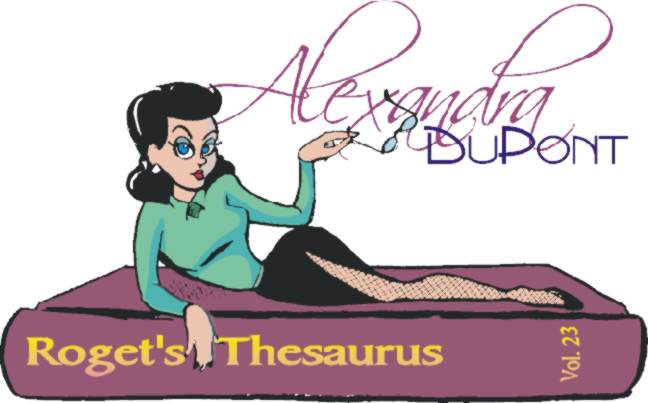Hi, everyone. "Moriarty" here with some Rumblings From The Lab...
Yes, I know… now I’m not only late with my own work, but that of other contributors. This is a very real problem, compounded by server maintainence and other issues over the long weekend. But now, here at last, the second part (you can find Part One RIGHT HERE) of Alexandra DuPont’s enormous in-depth interview with Jeff Smith:
PART II
MEMORIES OF SPARKY
You shared the stage with Garry Trudeau at the National Cartoonists Society Awards.
Well, I wasn't actually on the stage at the same moment; we both won awards that night. It was a thrill for me - I'm sure Garry Trudeau had no idea who I was.
I remember that night was the 50th anniversary of the National Cartoonists Society, and everyone was there. There was a little cocktail party before the awards ceremony, and it's a black-tie event, so everybody's in their tux - and I saw Charles Schulz just havin' a drink with someone. I wanted to meet him, but my goal was: Just shake his hand, get in, get out, don't make a fool of yourself. [laughs]
I shook his hand and he was very polite. I'm sure he meets admiring cartoonists all the time, so I stepped back - and then he saw Vijaya, my wife, and his eyes just lit up, like, "Wooo!" And suddenly we were friends, and I got to talk with him a little bit more.
I'm making light. We actually did become pretty good friends with Sparky - had dinner with him a few times and went out to visit him.
Schulz is kind of the father of modern newspaper-strip comic timing. Did he ever expound on any theories about that?
Oh, not really, no. I was looking up, if you know what I'm saying - I didn't really question him or ask him anything. We'd actually just talk about comics that we liked, other people's work, stuff like that.
It's weird to think of Sparky having read "Bone."
Yeah, that was pretty good. I liked that. [laughs] He didn't want to read it at first; he didn't like comic books. But we had some mutual friends, and they were trying to get him to read it. His timing and sense of humor had a big effect on me, and it's obviously in "Bone." He finally read it, and then we got along great.
And now I have the image of Charles M. Schulz, in a tux, drinking, and hitting on your wife.
[laughs] No! He was absolutely a gentleman.... I just meant my wife is a lot better-looking than me. Oh, God - I've besmirched Charles Shultz's memory!
MILDLY INVASIVE QUESTIONS ABOUT MONEY and BUSINESS that are NEVERTHELESS ANSWERED
Let's talk about the early days of "Bone." At the time you launched the comic, there were a lot more of these do-it-yourself comic books. How long was it before "Bone" was paying for itself - before it became your sole source of income?
It was about two years, I think. I started it in July 1991, and about the first year, I was still directing commercials and doing animation at Character Builders. The second year, Vijaya and I decided, "Let's go ahead and take a crack at it." Vijaya had a good job that paid a lot of money, so we could try it.
That always helps.
Yeah. It's a good insurance plan.
And the second year, it was even worse - the sales just kept plummeting. But then suddenly there was a very fast turnaround, somewhere around issue 6 or 7: The numbers for the monthly orders stopped falling - and then it began this amazing, exponential doubling every issue.
So by the end of '92, or maybe into '93, it was my sole income. And I convinced Vijaya that she should quit her job at a little Silicon Valley startup company and help me run the thing.
That must have been a powerful moment when you realized you could actually be the breadwinner with this comic book.
Well, it took a while, actually, to talk Vijaya into it. Because here we were in San Francisco, and she's working at a computer firm in the middle of the computer boom, and I'm trying to talk her into quitting so we can make comic books. [laughs] It took about six months to convince her.
Do you know why the numbers started to climb?
Well, it's really hard to say. A few influential people picked up on it. Neil Gaiman was going on, like, Canadian science-fiction channels and saying, "'Bone' is good," and Dave Sim was running a preview of it in "Cerebus," Don Thompson of the Comics Buyers Guide was giving it a full-page preview - all right around the same time. And it just ... caught.
And "Bone" was the first Internet word-of-mouth book. I don't know if it's the first one, but suddenly there was this medium where, if you liked a book, you could get online at night and tell everyone. I mean everyone! Word about "Bone" spread instantly around the globe.
In those early days, how did you keep from losing momentum? I mean, really - you and Dave Sim are the only ones who've managed to stick it out to this degree.
Yeah, I do know what you mean: It's a long-haul dedication. Although I should point out that Dave has a partner - I mean, when you look at a "Cerebus" page, 80 percent of what you seeing was drawn by Gerhard. So don't forget my man Gerhard. But I understand your point: It's a dedication to a single idea or theme and carrying it through that long is unusual in comic books, but it's not unusual in the broader art of cartooning. Dave and I would talk about this - it's not that unusual if you think about Charles Schulz, who dedicated 50 years to Snoopy and Charlie Brown. I mean, how many years did George Harriman draw "Krazy Kat"?
I'm not sure. How many years did he draw it?
Well, don't put me on the spot. [laughs] I think he started doing it in 1916 and ended in like 1945, give or take. But it's a long time.
One might have to think of it, I suppose, as a marathon.
I'm not sure I would do it again - how about that? [laughs] I don't know if I have time to do it again.
SPECIAL FEATURES and CARTOON MONKEYS
You published a behind-the-scenes book, the "Bone Reader," after Book Three came out - but then you let it go out of print. It was sort of like the DVD special features of "Bone." Are we going to see that in print again?
Yes, I think so. I originally did that, exactly as you said, as the "special features" between Act One and Act Two, to kind of split of this giant story into three parts. And there were things about that book I really liked - the technology that allowed us to show the early sketches and things like that - but there's not enough explanation in the book. There's no through-line.
So instead of doing another [behind-the-scenes book] after the next act break, I thought, "Why don't I just wait until the end, and I can do the whole book right?" I wanted to do something like that Disney Illusion of Life book - maybe not that big, but....
Will there be an educational component - you know, a "how-to" for aspiring cartoonists?
That's a good idea, although I wasn't picturing a step-by-step guide. Mostly I just thought [the book would say], "Here's what I did, and if you want to copy it, go for it. If you just want to know how I made all my mistakes, you can find that out, too."
So basically, when "Bone" is finished, you'll have the whole story in this sort of omnibus edition a la Lord of the Rings - and there will be this extra volume that's sort of like those behind-the-scenes books by Tolkien's son.
Right now, I sell the first three books in a slipcase and the second three books in a slipcase - and as soon as I have the ninth one done, there will be a third slipcase with the last three books in it. And I always thought it would be fun to have a fourth slipcase that had "Rose," "Stupid Rat Tales," and a "Bone Reader"-type, appendix-type book. There'd be a nice little architecture to that whole setup.
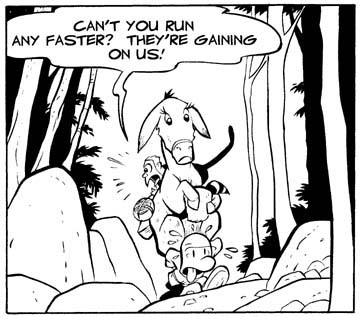
And on "Big Johnson Bone," by the way, congratulations on finding another way to draw a cartoon monkey.
[laughs] That character was a lot of fun. Tom Sniegoski wrote that story, and he just thinks monkeys are the funniest things.
Monkeys are funny.
Monkeys are funny.
Does it feel like a vacation when you're only drawing and not writing the story?
"Big Johnson Bone" was actually very difficult for me - because when I write, I almost subconsciously pave the way for the artist. I make sure that if somebody's talking first in one panel, he's talking first in the second panel - he's on the left in one panel and he stays on the left in the next panel. But other guys who just write and don't draw don't really worry about that kind of stuff. It was a lot more difficult to make the layouts and the staging work than I thought it was going to be.
There's a lot of dialogue in that book.
See? You've got somebody who's a writer, and he wants to say everything. Tom's humor is all very verbal, whereas my humor involves a lot more sight gags. But Big Johnson Bone's supposed to a very broad, American folktale character - a very talky, braggy character, like Pecos Bill or Paul Bunyan.
LEGENDS of OHIO (with RIFFING on the TALENTS of PAUL POPE)
Tolkien said he wrote "Lord of the Rings" because he wanted to create a mythology for England. Because of the way you use Old Man's Cave in "Bone," you're kind of writing the alternate mythology of Ohio. [laughs]
That's, um, a very interesting thought.
How much of Ohio shows up in the comic?
Well, historically, it's complete balderdash...
Well, of course.
But topographically, it's very much Ohio. People probably picture Ohio as cornfields and flat - and the northern part of the state is - but the lower half if the state is Appalachia; it's foothills and gorges and caves and forest. It's very beautiful. And a lot of the dialects the "Bone" characters have are southern Ohio.
Well, Columbus, Ohio, turns up a lot in Paul Pope's Mars - in P-City - in his comic "THB."
Well, you know, Paul's from Columbus. Actually, from a little bit north of Columbus, but he went to college down here. He's one of my very best friends in comics, that's for sure - one of those people whose artwork I admire the most, as well.
And he's evolved so much as an artist. The only hazard from that, of course, is that he's now holding "THB" issues 1-5 out of print because he wants to re-draw them all. Which is frustrating.
[inhales/sighs] Yeah, it's frustrating having to wait, but I've actually talked to him about it quite a bit - and I think it's gonna be worth it.
Have you seen pages from "THB v. 3" [the complete re-draw of "THB"'s early issues that Pope's working on intermittently]?
Yes, I have. It's absolutely stunning. And his artwork is oversized: He draws it at twice the size that most comic-book guys draw. So he's drawing on things that look like posters - with big, giant slaps of paint all over the place. His originals are really something to see.
And he can do like four pages a day - some appalling amount of output.
And you go around his studio and there's just piles of comics that he hasn't gotten around to printing yet. I don't know what he's waiting for. I mean, there's a huge amount of work.
MAKING 'BONE's
Let's talk about your working method. How long does it take you to write an issue?
It's kind of difficult to say, because I don't do anything in a linear fashion - I don't write it first, then letter it, then pencil it, and do "page one, page two." I take about two-and-a-half months, approximately, to do a comic book.... Picture taking all 22 pages of a comic book and laying them on the floor and then slowly bringing them all up through the process of lettering, penciling and inking.
So a page could be inked while another one is still being written.
Yeah. It's a lot of a work - it's almost cruel, the hours that comic-book artists put in alone, in a room, with nothing but a stereo.
To keep myself from going crazy, I might go, "Tonight, I'm just going to draw all the panels that I really want to ink." Or I might just do faces. In fact, a lot of times, I'll just go through and do all the faces - because the acting is important, and later on, as you get closer to your deadline and things start getting rushed, you start having to make decisions about what's going to get blown off - "I'm not going to be able to put as much detail here as I wanted" - so you've got to make sure the acting in the faces is taken care of.
I do that first, sometimes, throughout the whole book, so the inking and the staging is taken care of, and in those final hours when I'm panicking, that won't be affected.
I'd imagine that would also help you get a real through-line to the acting - I mean, one of the things that's strongest about "Bone" is that it's unusually fluid.
Well, I do view it almost as you would a storyboard; I do like to make sure that, visually, everything tracks - left to right, top to bottom - all the way through. The staging should all be very real; the implied motion should really move the characters along and give you cues, as a reader, as to how fast to read it.
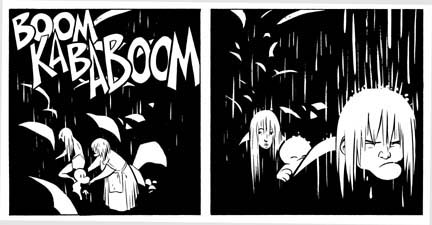
One of things I see in "Bone" - which I see in almost no other comics - is that you'll write these action "set pieces" that are almost like Hollywood set pieces, and you'll spin them out over several issues. I'm thinking specifically of that fantastic sequence in, I believe, "Eyes of the Storm," where Bone and Thorn are hunting for Grandma Ben in the rainstorm and everything's illuminated by lightning flashes. Spinning a single sequence out over several issues is pretty unusual in comics.
Well, partly, I'm sure, that's because of my fascination with animation and film. And I try to see the characters moving as if they were moving in real time. It's kind of fun to explore how I can get the reader to hear the thunder, or to experience the flash, or to sense the atmosphere that I'm trying to portray.
As far as stretching [a sequence] out over several issues, I think that sort of comes from my outsider status: I got into this to tell a single story from the beginning, and I always - at least from very early on - knew that the end product was the collected books ... what we call "graphic novels" now. So I was always planning it in terms of the books, and not in terms of the individual issues - and that breaks with the tradition of what most people think of as "comics," which is that you just tell a story for that month, and even if it continues, you certainly wouldn't have the scene continue over that length of time; you end a little episode for Spider-Man and Mary Jane or whatever, and get Dr. Octopus in the jail cell. That's the traditional comic book. But I was preparing something for the bookshelves.
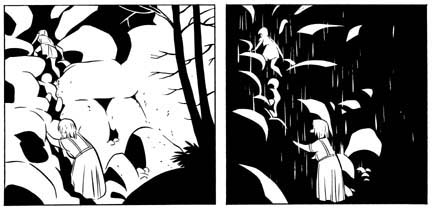
Do you think it's easier or harder to plan out a long, multi-issue sequence?
Well, for me it's easier: I mean, I think that way naturally. I don't know if it would be easier for someone else or not.
You've said about your comic timing in "Bone" that it isn't funny if it doesn't "snap." How much revision is involved in achieving that "snap"?
Well, when I'm writing, I kind of know what the scene is and what the situation is, and I know the characters' personalities very well. And you have to have certain objectives to get across in a scene - to figure out what [a character wants] at that moment, or some story/plot point that has to be made. You get those parameters figured out, and then you do a little role-playing - at least I do; I kind of get, you know, Fone Bone talking to Phoney Bone, or Phoney Bone arguing with Smiley Bone - and just get them going back and forth in my head. And the characters, as you're role-playing, will kind of take over.
And when I start to see something funny developing, it's like, "Yeah yeah yeah! Okay, stop; think about that; write it down. What was it that was just funny?" And I just try to catch it there.
Making a joke is a lot of work. I rarely laugh. It has to be constructed, it has to be set up correctly - sometimes it can take a couple of pages of material to set up a good joke, because you have to plant the seeds.
Right. It's architecture.
Yeah - there's a lot of construction involved. Only Smiley Bone makes me laugh. Not every time, but sometimes his jokes actually make me laugh out loud at my desk. He's the only one, though; I just don't know where he's coming from. [laughs]
Yeah, Smiley's the ambiguous character of the bunch. He kind of plays all sides; I love that he's always in on Phoney's con games, but everyone's only mad at Phoney.
Yeah. I don't know how he pulls it off. He's a bit of a tribute to the character Wimpy in the original Popeye cartoons, "Thimble Theater." Those are brilliant. And of course, Grandma Ben is pretty much a tribute to Popeye - the way she walks, her super-strength, everything.
One always looks for an anchor tattoo on her forearm.
[Laughs] I'm thinking about getting one of those.
What happened to the cigarette that the Great Red Dragon used to have in his mouth? We haven't seen that in a while.
I think his cigarettes got left in the trash can of my house that I left back in California.
In 1994, I was trying to quit, and I remember going out the door to attend the San Diego Comic Book Convention that year, and I turned around and crumpled my pack and threw it back in the house and closed the door and went to the show - and I never smoked again. And the Dragon just never had a cigarette again. I mean, I never thought, "I don't want the dragon to have a cigarette anymore" - I just didn't draw one after that. And I didn't go back and white them out from the earlier [issues] or anything.
I noticed recently that when I did a limited-edition print for that San Diego show, for their comic-book expo, in 1994 - that the Dragon has a toothpick in his mouth instead of cigarette, because I was chewing toothpicks trying to build up to quitting.
Next thing you know he'll be chewing gum.
Chewing gum, sucking on cough drops. See if he has the patch on his shoulder.
IMPROVISING THE DETAILS
You know, some cartoonists don't even write a script - they're very much about feeling out the story, literally letting the characters and the visuals tell the story as they go along. You're obviously working in a more structured way, but there's still a lot of improvisation in there, isn't there?
Yes, it's very similar. Very similar. I mean, I have a goal, but I have no plan to get there - and as long as I reach the goal, I don't think it matters how you get there.
I've heard Miyazaki say things like that, and I very much agree with that approach to storytelling. Because that's what storytelling is - it's tapping into wherever dreams come from. You tap into that source, and it just takes off. In other words, there's software inside your hardware - or whatever that metaphor should be - [laughs] that's inside you, and you can tap into that.
Right. I've read a lot of interviews with Paul Pope - because, you know, he always publishes interviews with himself in his own comics -
[Laughs] There's something charming about that, isn't there?
- but one of the things he says is that he doesn't believe in scripts. Chris Ware feels the same way; he doesn't write scripts for his elaborate, textually dense comics in advance. He starts with a blank page and works his way through.
That's very much how I do it - I just set out and go. Again, I have a goal to get to, and how it gets there, I never know. And especially now, here at the end, I don't even know how many pages are going to be in an issue until about three days before it goes to press - which is, of course, a terrifying and cruel thing to do to Vijaya and Kathleen [Glosan, the third Cartoon Books employee]. I think they realize they only have to go through it four more times, and we'll survive. [laughs]
The story must tell itself, period. If it isn't working, if it isn't true, you can't let it leave the building. And you do have to boil it down. Because there are a certain amount of beats that have to be hit, you know? You have to communicate what's important to Fone Bone and you have to communicate plot points and you have to do what's necessary - and you may only have a page to do it. So you find the cleanest, simplest, clearest way to communicate that. And then make it funny. [laughs]
TONAL SHIFTS, GHOST CIRCLES and LETTERING FONTS
Obviously, the first "Bone" collection, "Out from Boneville," is largely humor-driven - and then you skip directly to Volume Seven, "Ghost Circles" and it's just this huge shift tonally. I mean, "Ghost Circles" is a very dark story. All that and you're working in the visual medium of comics, but the biggest weapon the enemy uses - the "ghost circle" - is completely invisible.
Yeah. The concept of the ghost circles has been difficult to convey, and there are some people who have no idea what I'm talking about. [laughs] So I'm not sure how successful I've been at it. But most people seem to get it.
Where'd you get the idea for ghost circles?
The idea that our world and another, invisible world just beyond the veil could blend has always been in the comic - like when Fone Bone and Smiley were taking the baby rat creature Bartleby back to his home in the mountains, and they passed through an ancient rat-creature temple, and they ended up hallucinating and seeing giant Kingdoks that weren't there.
The actual name "ghost circles" came later on when I was working on the movie. Because films are even more visually driven than comic books, we - "we" meaning me and some of the Character Builders guys as we were working on the film - were trying to come up with a visual way to express the Hooded One and the Locust's power. And we started out with the idea that crop circles were created by the Locust - but that quickly ballooned into a much more deadly circle that you walk into and you are in the netherworld.
You're negated, basically.
Yeah, pretty much. And we couldn't come up with a name for them. I just called them "crop circles." And then the name hit me like a lightning bolt - "ghost circles."
But the whole thing is very different from what we talked about in the film. In the film, like I said, it was a visible crop circle; in the comic, it's invisible. The veil between our world and the world of the dead has been pierced, and a toxic, nightmarish pool of negative material has formed.
To go back to your original question on the tone of the first books: One of the secrets to me of Lord of the Rings is that you start out reading it, and it's this little story about these entertaining and delightful characters, the Hobbits, and you only slowly realize that this is a big story that they've gotten themselves mixed up in. So translating that into comic books, for me, meant starting out like Carl Barks. I was hoping that people could open the book and be caught right away with a fairly familiar set of characters - Fone Bone, Phoney Bone and Smiley are Mickey, Donald and Goofy; they're Bugs, Daffy and Porky; they're Groucho, Chico and Harpo, you know? And I wanted to slowly move from a comfortable, Carl Barks type of a story into a huge Miyazaki imagination meltdown.
And I didn't want anyone to have even a hint that I wanted to do a big, Lord of the Rings thing. Because even though it's cool now, 12 years ago it wasn't, you know?
Now, you use a custom-made lettering font in "Bone." How do you respond to the cries of purists who say that the computer lettering of comics is somehow a dishonest thing?
Well, I think I understand what people are talking about in general - because I believe that a person who draws a strip should letter it, because graphically that makes it whole. They should be organic to each other. It's always been a little disconcerting to me to see a comic with, you know, computerized Helvetica - I mean, you kind of picture a mechanical voice coming out [of the character's mouth], almost.
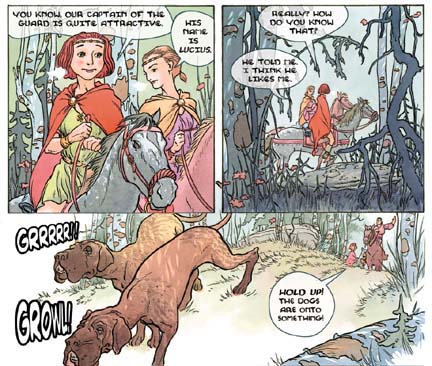
When Charles Vess and I did "Rose" together, Charles had his lettering digitized onto a font, because I felt there was an integrated whole to be achieved here. And it's actually been handy in the overseas translations, too. I can just send them BoneFont and VessFont on a disk, and they can do the German edition of "Rose" with Charles' lettering.
That's my first answer. My second answer is: You know, if there's anyone - I mean cartoonists or critics - who think they're more of a purist than me, fuck 'em. Let 'em do their own book.
I guess if I was in your shoes, my answer would be: "When you put out a nine-volume comics cycle with 55 issues by yourself" -
- without Gerhard.... That's one of the things that bothered me about the whole self-publishing "movement". There were all these rules about what you could and couldn't do. No computer lettering; put your book out on a certain schedule; and no merchandising. Where did all these little rules come from? The whole point of starting your own company is so you never have to ask anybody's permission.
dupont@dvdjournal.com